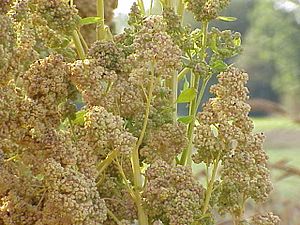Gluten-free diet facts for kids
A gluten-free diet is a way of eating that avoids foods with gluten. Gluten is a type of protein. You can find it in grains like wheat, barley, and rye. Some people also avoid oats on this diet. Many common foods like bread, cakes, pasta, and pizza contain gluten. Gluten is also sometimes added to foods to help them taste better, stay fresh, or become thicker.
Sometimes, even things that aren't food, like some medications or vitamin supplements, might have gluten. It can be used to hold tablets together.
Contents
Why People Eat Gluten-Free
The main reason people follow a gluten-free diet is for their health. It is the only treatment for two conditions:
- Celiac disease: This is an autoimmune disease. If someone with celiac disease eats gluten, it damages their small intestine. This makes it hard for their body to get important nutrients from food.
- Wheat allergy: This is when someone's body reacts badly to wheat. It's different from celiac disease, but also means avoiding wheat.
Some people also choose a gluten-free diet for other reasons. However, doctors agree it is medically necessary only for celiac disease and wheat allergy.
Foods to Avoid and Enjoy
When following a gluten-free diet, it's important to know which foods contain gluten.
Foods with Gluten
- Grains: Wheat (and all its forms like spelt, farro, durum), barley, and rye.
- Common Foods: Most breads, pastas, cakes, cookies, and pizzas.
- Drinks: Many types of beer and some whiskeys are made with gluten-containing grains.
- Hidden Gluten: Gluten can be found in unexpected places. It might be in sauces, soups, salad dressings, ice cream, or even ketchup. It can be used as a thickener or flavor.
Gluten-Free Options
Many foods are naturally gluten-free. These include:
- Fruits and Vegetables: All fresh fruits and vegetables are naturally gluten-free.
- Meats and Fish: Plain, unprocessed meats, poultry, and fish are gluten-free.
- Dairy: Most dairy products like milk, cheese, and yogurt are gluten-free.
- Gluten-Free Grains: There are many grains that do not contain gluten. Examples include rice, corn, quinoa, buckwheat, millet, and sorghum.
- Special Products: Many grocery stores now have special sections for gluten-free foods. You can find gluten-free breads, pastas, and snacks. These are made with gluten-free flours.
Important Things to Know
Following a gluten-free diet means being careful about what you eat.
Reading Labels
It's very important to read food labels carefully. Look for words like "wheat," "barley," "rye," or "malt." Many products are now labeled "gluten-free," which makes it easier.
Cross-Contamination
Even a tiny amount of gluten can be a problem for people with celiac disease. This is called cross-contamination. It can happen if gluten-free food touches food or surfaces that have gluten. For example, using the same toaster for regular bread and gluten-free bread could be an issue.
Oats and Gluten-Free Diets
Some people on a gluten-free diet also avoid oats. This is because oats can sometimes be processed in factories that also handle wheat, leading to cross-contamination. Also, some people with celiac disease might react to a protein in oats called avenin, which is similar to gluten. Doctors have different opinions on whether oats are safe for everyone with celiac disease.
Non-Food Items
Gluten can even be found in some non-food items. For example, some lip balms and lipsticks might contain gluten. People who need to avoid gluten strictly should check these products too.
Images for kids
-
One breadcrumb of this size contains enough gluten to cause a reaction in people with coeliac disease when they are following a gluten-free diet. Even small amounts can prevent recovery.
See also
 In Spanish: Dieta sin gluten para niños
In Spanish: Dieta sin gluten para niños







